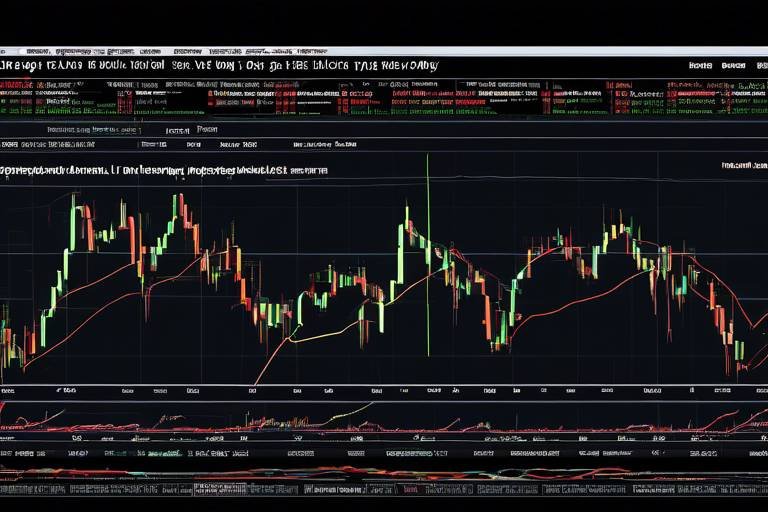Understanding Technical Analysis - A Beginner's Guide
Welcome to the fascinating world of technical analysis, where numbers and charts come alive to tell a story about market movements! If you're new to trading, you might be wondering what all the fuss is about. Why do traders obsess over price charts and patterns? The answer lies in the ability to make informed decisions based on historical data and market behavior. This guide provides an overview of technical analysis, its significance in trading, and key concepts that beginners need to grasp to effectively analyze market trends and make informed decisions.
At its core, technical analysis is the study of past market data, primarily price and volume, to forecast future price movements. Unlike fundamental analysis, which focuses on a company's financial health and economic factors, technical analysis is all about the numbers. Imagine trying to predict the weather by only looking at the sky—technical analysis is like using a weather app that compiles data from various sources to give you the most accurate forecast possible. By evaluating past price movements, traders aim to identify patterns that can signal potential future trends, helping them make educated trading decisions.
To get started with technical analysis, it’s essential to understand some key concepts that will form the foundation of your trading knowledge. These include trends, support and resistance levels, and chart patterns. By grasping these ideas, you'll be better equipped to analyze charts and make informed trading choices. Let's break these concepts down further.
Trends are the backbone of technical analysis, indicating the general direction of a market or stock price. Think of trends as the currents in an ocean; they can guide your trading boat in the right direction if you know how to read them. There are three primary types of trends: uptrends, downtrends, and sideways trends. Understanding these trends is crucial because they can help you predict where prices are headed.
An uptrend is characterized by rising prices and higher highs. This is like climbing a staircase, where each step is higher than the last. To identify an uptrend, traders look for a series of higher highs and higher lows on the price chart. Trading within an uptrend can be particularly lucrative, as it often indicates strong buying pressure. Strategies such as buying on dips or using moving averages can help traders capitalize on these upward movements.
Conversely, a downtrend features falling prices and lower lows, resembling a downward slope. Identifying downtrends is essential for traders looking to short-sell or protect their investments. Recognizing a series of lower highs and lower lows can signal a bearish market. Strategies for trading in a downtrend may include selling short or using protective stop-loss orders to mitigate losses.
Support and resistance levels are critical in technical analysis, acting as psychological barriers for traders. Support is the price level where a stock tends to stop falling and may bounce back up, while resistance is where the price tends to stop rising and may fall back down. Identifying these levels can significantly enhance your trading strategy. For example, if a stock consistently bounces off a support level, it might be a good buying opportunity. Conversely, if it struggles to break through a resistance level, it may be wise to consider selling.
Chart patterns are visual representations of price movements that can provide valuable insights into market trends. Recognizing these patterns can help traders anticipate potential market signals. Some common patterns include head and shoulders, flags, and triangles. Understanding these patterns can be likened to reading a map; they guide you through the terrain of the market.
The head and shoulders pattern is one of the most reliable indicators of a potential reversal. It resembles a head with two shoulders on either side, signaling that the price may soon change direction. Identifying this pattern involves looking for a peak (the head) followed by two lower peaks (the shoulders). Recognizing this pattern can be a game-changer for traders, as it often indicates a shift from bullish to bearish sentiment.
Flags and pennants are continuation patterns that suggest a brief consolidation period before the previous trend resumes. Flags look like small rectangles that slope against the prevailing trend, while pennants are small symmetrical triangles. Spotting these patterns can provide traders with excellent entry points to capitalize on the continuation of the trend. Think of them as a brief pause in a race, where runners catch their breath before sprinting ahead again.
- What is the main difference between technical analysis and fundamental analysis? Technical analysis focuses on price movements and market behavior, while fundamental analysis examines a company's financial health and economic factors.
- How can I start learning technical analysis? Begin by studying price charts, understanding key concepts like trends and support/resistance, and practicing with demo accounts.
- Are there any tools I can use for technical analysis? Yes! There are many charting tools and software available, such as TradingView and MetaTrader, that can help you analyze market data.

What is Technical Analysis?
Technical analysis is a method used by traders and investors to evaluate securities by analyzing statistics generated from market activity. This includes price movements and trading volume. Unlike fundamental analysis, which focuses on a company's financial health and economic factors, technical analysis is all about the numbers and charts. Imagine trying to navigate a ship without a compass; that’s what trading without technical analysis can feel like. It helps you make sense of the chaos in the market and can guide you in making more informed decisions.
The primary goal of technical analysis is to identify patterns and trends in the market that can inform future price movements. Traders use various tools and indicators to analyze these patterns and predict where a stock or security might be headed next. For instance, if you notice that a stock has consistently bounced back from a certain price level, that level may be considered a support level. Conversely, if a stock struggles to rise above a certain price, that might be a resistance level.
One of the fascinating aspects of technical analysis is its reliance on the idea that market sentiment and psychology play a significant role in price movements. The market is driven by the collective actions of traders, and their emotions can create patterns that are often predictable. Think of it like a game of chess; while each player has their strategy, the moves they make are influenced by their perception of the game. In the same way, traders react to market conditions, news events, and even social media chatter, creating a tapestry of price movements that can be analyzed.
To sum it up, technical analysis is not just about crunching numbers; it's about understanding the story behind the price movements. By grasping the fundamentals of technical analysis, traders can better position themselves to take advantage of market opportunities and mitigate risks. Whether you’re a seasoned trader or just starting, mastering this skill can significantly enhance your trading strategy.
In the upcoming sections, we’ll delve deeper into key concepts such as trends, support and resistance, and chart patterns. These elements are crucial for anyone looking to harness the power of technical analysis effectively.

Key Concepts in Technical Analysis
Understanding the key concepts in technical analysis is like having a map when you're lost in the woods. It provides direction and clarity, helping you navigate the often tumultuous waters of trading. At its core, technical analysis relies on the study of price movements and volume to forecast future price trends. But what does that actually mean? Let's break it down into some essential components that every beginner should know.
One of the most fundamental concepts in technical analysis is the idea of trends. Trends are the overarching direction in which a market or a specific security is moving. They can be categorized into three main types: uptrends, downtrends, and sideways trends. Recognizing these trends is crucial because they can significantly influence your trading decisions. For instance, if you identify an uptrend, it might be a good time to consider buying, while a downtrend could signal a potential sell-off.
Next up, we have support and resistance. These levels act as psychological barriers in the market. Support is the price level at which a stock tends to stop falling and may even bounce back up, while resistance is the level where a stock typically stops rising and may reverse direction. Imagine these levels as invisible walls that traders react to. Identifying these points can help you make strategic decisions about when to enter or exit a trade. For example, if a stock price approaches a strong support level, it might be an ideal time to buy, anticipating a rebound.
To illustrate these concepts further, here’s a simple table summarizing the differences between support and resistance:
| Concept | Description |
|---|---|
| Support | The price level where a downtrend can be expected to pause due to a concentration of demand. |
| Resistance | The price level where an uptrend can be expected to pause due to a concentration of supply. |
Finally, let’s talk about chart patterns. These are visual representations of price movements that can help traders identify potential future movements. Patterns like head and shoulders, flags, and triangles provide insights into market sentiment. For example, a head and shoulders pattern often signals a reversal in trend, indicating that it might be time to either buy or sell. Recognizing these patterns is essential for making informed trading decisions.
In summary, mastering these key concepts—trends, support and resistance, and chart patterns—will lay a solid foundation for your technical analysis journey. It's like learning the rules of a game before you start playing; without understanding these basics, you might find yourself lost in the chaos of the market. So, keep these principles at the forefront of your trading strategy, and you'll be well on your way to becoming a savvy trader.
- What is the difference between technical analysis and fundamental analysis?
Technical analysis focuses on price movements and market trends, while fundamental analysis looks at a company's financial health and economic factors. - How can I identify trends in the market?
Trends can be identified using various tools such as moving averages, trend lines, and chart patterns. - What are support and resistance levels?
Support levels are price points where a stock tends to stop falling, while resistance levels are where a stock tends to stop rising.

Trends
When diving into the world of technical analysis, understanding is like learning the pulse of the market. Trends indicate the general direction in which a market or a stock price is moving. They are essential for traders because they provide a roadmap for making informed decisions. Just as a river flows in one direction, so do market trends, and recognizing this flow can significantly impact your trading success.
There are three main types of trends that every trader should familiarize themselves with: uptrends, downtrends, and sideways trends. Each of these trends has its own characteristics and implications for trading strategies. Understanding these can be the difference between riding the wave of profit and getting swept away by losses.
In an uptrend, prices move higher, characterized by a series of higher highs and higher lows. Think of it as climbing a staircase; each step represents a new high, and the overall movement is upward. Identifying an uptrend can be incredibly rewarding, as traders can capitalize on the momentum by buying into the market. But how do you spot an uptrend? Look for a series of peaks and troughs that consistently rise, and you'll have a clear indication of a bullish market.
On the flip side, a downtrend is marked by falling prices, showcasing a series of lower highs and lower lows. Imagine sliding down a slope; the further you go, the lower you get. This trend indicates a bearish market, and recognizing it allows traders to implement strategies such as short selling. To identify a downtrend, watch for consistent price drops and lower peaks over time.
Lastly, we have the sideways trend, which can be a bit tricky. In this scenario, prices move within a horizontal range, lacking a clear upward or downward direction. It’s like being stuck in traffic—neither moving forward nor backward. Many traders often find themselves confused in sideways markets, but they can also present opportunities for range trading. To identify a sideways trend, look for price movements that oscillate between defined support and resistance levels without breaking through.
Understanding these trends is crucial not only for making trades but also for managing risk. For instance, if you know the market is in an uptrend, you might be more inclined to hold onto your positions longer, while in a downtrend, you might want to cut your losses quicker. The key takeaway here is that recognizing trends can help you align your trading strategy with the market's natural flow.
To summarize, here’s a quick look at the types of trends:
| Type of Trend | Characteristics | Trading Strategy |
|---|---|---|
| Uptrend | Higher highs and higher lows | Buy into the market |
| Downtrend | Lower highs and lower lows | Short selling |
| Sideways Trend | Prices move horizontally | Range trading |
So, the next time you analyze a stock or market, remember to look for these trends. They are your guiding compass in the unpredictable ocean of trading!

Uptrends
When we talk about , we’re diving into a world where prices are on the rise, and optimism fills the air. An uptrend is not just a fleeting moment; it’s a sustained movement characterized by a series of higher highs and higher lows. Imagine riding a wave at the beach—each crest (or high) is a peak that gives you a thrill, while the dips (or lows) are just part of the ride, never falling below the last low. Understanding how to identify and trade within uptrends can be a game-changer for any trader.
So, how do you spot an uptrend? Look for these key indicators:
- Higher Highs: Each peak is higher than the previous one.
- Higher Lows: Each trough is also higher than the last, confirming the upward momentum.
- Volume Increase: Often, you’ll notice that as prices rise, trading volume tends to increase, indicating strong buyer interest.
Now, let’s break it down a bit more. Imagine you’re tracking a stock that has been consistently climbing for a few weeks. You notice that it hits a new high at $50, then dips slightly to $48 before climbing back up to $55. This pattern of higher highs and higher lows is your golden ticket to recognizing an uptrend. But what’s next? How do you ride this wave without wiping out?
One effective strategy for trading within an uptrend is to use trend lines. Draw a line connecting the higher lows, which creates a support level. This line acts like a safety net, giving you a visual cue of where the price might bounce back up. When the price approaches this trend line, it’s often seen as a good buying opportunity, as long as the overall trend remains intact.
Moreover, utilizing technical indicators such as the Moving Average can also provide clarity. A simple moving average (SMA) can help smooth out price fluctuations and give you a clearer picture of the trend. For example, if the price consistently stays above the 50-day SMA, it reinforces the idea that the uptrend is strong.
However, it’s essential to remember that no trend lasts forever. Just like every wave eventually crashes, uptrends can reverse. Therefore, keep an eye out for signs of weakening momentum, such as:
- Divergence: If the price is making new highs but indicators like the Relative Strength Index (RSI) show lower highs, it could signal a potential reversal.
- Breaking Trend Lines: If the price breaks below your trend line support, it may indicate that the uptrend is losing strength.
In conclusion, mastering the art of identifying and trading uptrends can lead to significant opportunities in the market. By understanding the characteristics of an uptrend and employing effective trading strategies, you can position yourself to capitalize on rising prices, making informed decisions that align with market movements.
1. How can I identify an uptrend in a stock?
You can identify an uptrend by looking for a series of higher highs and higher lows on the price chart. Additionally, increasing volume during price rises can indicate strong support for the trend.
2. What is the importance of trend lines in trading?
Trend lines help traders visualize support and resistance levels. They provide a framework for making decisions about when to enter or exit trades, especially during an uptrend.
3. Can an uptrend last indefinitely?
No, uptrends do not last forever. Market conditions change, and trends can reverse. It’s crucial to stay alert for signs of weakening momentum or breakouts below established trend lines.

Downtrends
In the world of trading, are crucial to understand, especially for those who are navigating the often turbulent waters of the stock market. A downtrend is characterized by a series of declining prices, where each successive low is lower than the previous one. This movement can be likened to a roller coaster that’s on the way down—while it may feel thrilling for some, it often signals caution for traders. Recognizing a downtrend is essential for making informed decisions, whether you're looking to short a stock or simply avoid potential losses.
Identifying a downtrend involves analyzing price charts and looking for specific patterns. Typically, you’ll want to look for lower highs and lower lows, which visually appear as a downward slope on a chart. This pattern provides a clear indication that the market sentiment is bearish, meaning that sellers are in control. It’s like watching a game where one team consistently scores against the other; you can almost predict the outcome based on the momentum.
To effectively trade within a downtrend, it’s vital to employ a few strategies. Here are some key points to consider:
- Timing Your Entry: Look for short-selling opportunities when the price retraces to a resistance level. This can be compared to fishing; sometimes, you have to wait for the fish to come to you instead of chasing them.
- Using Technical Indicators: Tools like moving averages or the Relative Strength Index (RSI) can help confirm the strength of a downtrend. Think of these indicators as your compass, guiding you through the fog of market uncertainty.
- Setting Stop-Loss Orders: Always protect your capital by placing stop-loss orders above recent highs. This acts as a safety net, ensuring that you don’t fall too deep into the bearish pit.
Understanding the psychology behind downtrends is equally important. When prices fall, fear often grips the market, leading to panic selling. This emotional reaction can exacerbate the downtrend, creating a vicious cycle. Traders who can remain calm and analytical during these times have a better chance of capitalizing on the market’s movements. It’s all about maintaining a clear head and not getting swept away by the emotional tide.
In summary, downtrends present both challenges and opportunities for traders. By recognizing the signs and employing effective strategies, you can navigate these downward spirals with confidence. Remember, every downtrend eventually leads to a turning point; understanding when to pivot can make all the difference in your trading journey.
Q: What is a downtrend in trading?
A downtrend refers to a market condition where the price of a security is consistently declining, characterized by lower highs and lower lows.
Q: How can I identify a downtrend?
You can identify a downtrend by analyzing price charts, looking for patterns of lower highs and lower lows, and using technical indicators to confirm the trend.
Q: What strategies can I use in a downtrend?
Some effective strategies include short selling, using technical indicators for confirmation, and setting stop-loss orders to protect your investments.

Support and Resistance
Support and resistance are two of the most critical concepts in technical analysis, acting as psychological barriers for traders and investors. Imagine you’re at a concert, and the crowd is pushing against a barrier. The barrier represents support when the crowd tries to push forward but can't break through, while resistance is like a ceiling that prevents the crowd from going any higher. In the world of trading, these levels are essential for making informed decisions. Understanding how to identify and utilize these levels can significantly enhance your trading strategy.
Support is the price level at which a stock or market tends to stop falling and may even bounce back up. It’s like a safety net for prices, where buying interest is strong enough to overcome selling pressure. Conversely, resistance is the price level where selling interest is strong enough to overcome buying pressure, preventing prices from rising further. When prices approach these levels, they often exhibit predictable behavior. For instance, when a stock hits support, it might be a good buying opportunity, while hitting resistance could signal a potential sell.
To effectively analyze support and resistance levels, traders often look at historical price data. Here are some common methods to identify these levels:
- Historical Price Levels: Look at past price movements. If a stock has bounced off a particular price multiple times, it’s likely a support level. Similarly, if it has repeatedly failed to break through a certain price, that’s a resistance level.
- Trendlines: Drawing trendlines can help visualize support and resistance. An upward trendline can act as support, while a downward trendline can serve as resistance.
- Moving Averages: Many traders use moving averages as dynamic support and resistance levels. For instance, the 50-day or 200-day moving averages often act as significant levels where price may reverse.
It's also important to note that support and resistance levels are not set in stone. They can change over time due to market conditions, news events, or changes in investor sentiment. For example, if a stock breaks through a resistance level, that level may become a new support level, and vice versa. This phenomenon is known as role reversal and is a crucial concept for traders to grasp.
Incorporating support and resistance into your trading strategy can be incredibly beneficial. Traders often use these levels to set stop-loss orders and take-profit targets, which can help manage risk effectively. For instance, if you're entering a trade near a support level, you might place a stop-loss just below that level to minimize potential losses. On the other hand, if you're trading near resistance, you might set your take-profit target just below that level to lock in gains before any potential reversal.
In summary, understanding support and resistance is fundamental for any trader looking to navigate the complexities of the market. By recognizing these levels, traders can make more informed decisions, manage risk better, and ultimately improve their chances of success in trading. Remember, the key is not just to know where these levels are but to understand how they interact with price movements over time.
What is the difference between support and resistance?
Support is a price level where buying interest is strong enough to prevent the price from falling further, while resistance is a level where selling interest prevents the price from rising. Both are crucial in predicting price movements.
How can I identify support and resistance levels?
You can identify these levels by analyzing historical price data, using trendlines, and applying moving averages. Look for price points where the stock has reversed direction multiple times.
Can support and resistance levels change?
Yes, support and resistance levels can change over time due to market conditions and investor sentiment. A broken resistance level can become a new support level and vice versa.
Why are support and resistance important in trading?
They help traders make informed decisions about entry and exit points, manage risk, and set stop-loss and take-profit orders effectively.

Chart Patterns
Chart patterns are like the visual language of the market. They tell a story about price movements and can provide traders with insights into potential future trends. By recognizing these patterns, traders can make informed decisions about when to enter or exit a position. Just as a painter uses shapes and colors to convey emotions, traders use chart patterns to interpret market sentiment and predict price behavior.
There are several common chart patterns that every trader should be familiar with, each with its own unique implications. Understanding these patterns can be the difference between making a profitable trade or experiencing a loss. Here are a few of the most important patterns:
- Head and Shoulders: This pattern typically indicates a reversal in price direction. It consists of three peaks: a higher peak (the head) between two lower peaks (the shoulders). This formation suggests that the market is losing momentum, signaling a potential shift from bullish to bearish.
- Flags and Pennants: These are continuation patterns that occur after a strong price movement. Flags appear as rectangular shapes that slope against the prevailing trend, while pennants look like small symmetrical triangles. Both indicate that a brief consolidation is happening before the previous trend resumes.
- Triangles: Triangles can be ascending, descending, or symmetrical. They indicate a period of consolidation, where the price is narrowing down between support and resistance levels. This pattern often leads to a breakout, which can be either bullish or bearish.
Recognizing these patterns requires practice and a keen eye. Traders often use various tools, such as trend lines and indicators, to assist in identifying these formations. For example, when looking for a head and shoulders pattern, traders might draw trend lines to better visualize the peaks and troughs. Similarly, observing volume can provide additional confirmation of the strength of a pattern. A surge in volume during a breakout can signal that the market is ready to move decisively in one direction.
Chart patterns are not foolproof; they should be used in conjunction with other technical analysis tools and indicators. Think of them as a piece of a larger puzzle. Just as you wouldn’t rely on a single piece to understand the entire picture, you shouldn’t rely solely on chart patterns for trading decisions. Instead, consider them as valuable signals that, when combined with other analyses, can lead to more informed trading strategies.
In summary, chart patterns are essential for traders looking to navigate the complexities of the market. By learning to identify and interpret these patterns, traders can gain insights into market psychology and make more strategic decisions. Remember, practice makes perfect! The more you study these patterns, the more intuitive your trading decisions will become.
Q: What is the importance of chart patterns in trading?
A: Chart patterns help traders predict future price movements by analyzing historical price data. Recognizing these patterns can lead to better trading decisions and improved profitability.
Q: Can chart patterns guarantee success in trading?
A: No, chart patterns are not foolproof. They should be used in conjunction with other analysis tools and risk management strategies to increase the likelihood of successful trades.
Q: How can I practice identifying chart patterns?
A: You can practice by analyzing historical charts, using demo trading accounts, and employing charting software that highlights patterns. The more you practice, the more adept you'll become at recognizing these formations.

Head and Shoulders
The head and shoulders pattern is one of the most recognized and reliable indicators in technical analysis, often used by traders to predict market reversals. This pattern typically forms after an uptrend and signals a potential shift in the market's direction. Understanding this pattern can be a game-changer for your trading strategy, as it provides insights into when to enter or exit a trade. But what exactly does it look like, and how can you identify it?
The head and shoulders pattern consists of three peaks: the first peak (the left shoulder), a higher peak (the head), and the third peak (the right shoulder), which is lower than the head but similar in height to the left shoulder. Visually, it resembles a mountain range, and once you recognize it, you’ll see it pop up in charts quite frequently. Here’s a simple breakdown of the components:
| Component | Description |
|---|---|
| Left Shoulder | The first peak, indicating the market's initial upward move. |
| Head | The highest peak, showcasing a strong bullish trend before the market begins to reverse. |
| Right Shoulder | The final peak, which typically mirrors the left shoulder and suggests a weakening bullish trend. |
To confirm the head and shoulders pattern, traders look for a neckline, which is a horizontal line drawn through the lows of the left shoulder and the right shoulder. When the price breaks below this neckline after the right shoulder, it confirms the pattern and indicates a bearish reversal. This is where the magic happens! Traders often place sell orders just below the neckline to capitalize on the expected decline.
But wait, there's more! It’s essential to consider volume during this pattern formation. A decrease in volume during the formation of the left shoulder and head, followed by an increase as the price breaks below the neckline, can further validate the pattern. This volume confirmation helps traders feel more confident in their decision to enter a trade.
Now, you might be wondering, "How reliable is this pattern?" While no trading strategy is foolproof, the head and shoulders pattern has a strong historical track record. Many traders swear by it, but like any tool in your trading toolbox, it’s crucial to use it in conjunction with other indicators and analysis techniques to increase your chances of success.
In summary, the head and shoulders pattern is a powerful tool for identifying potential market reversals. By recognizing its formation and understanding its components, you can make more informed trading decisions. Remember, practice makes perfect, so keep an eye on your charts and watch for this pattern to appear!
- What is the significance of the head and shoulders pattern? It indicates a potential market reversal from bullish to bearish, providing traders with opportunities to profit.
- How can I confirm the head and shoulders pattern? Look for a break below the neckline with increased volume to confirm the pattern.
- Can the head and shoulders pattern appear in downtrends? Yes, the inverse head and shoulders pattern is a bullish reversal pattern that appears after a downtrend.

Flags and Pennants
Flags and pennants are fascinating chart patterns that traders often encounter in the world of technical analysis. They are classified as continuation patterns, which means they usually appear during a strong trend and indicate that the prior trend is likely to resume after a brief period of consolidation. Think of them as a pause in a race where the runners catch their breath before sprinting off again. Recognizing these patterns can provide traders with valuable insights into potential market movements.
To spot a flag or pennant, one must first identify the preceding strong price movement—this could be either an uptrend or a downtrend. A flag pattern typically resembles a rectangle or a parallelogram that slopes against the prevailing trend, while a pennant looks like a small symmetrical triangle. Both patterns suggest that the market is taking a breather before continuing in the direction of the original trend.
Let's delve a bit deeper into each pattern:
| Pattern | Shape | Indicates |
|---|---|---|
| Flags | Rectangular shape, sloping against the trend | Continuation of the trend |
| Pennants | Small symmetrical triangle | Continuation of the trend |
When trading flags and pennants, it’s essential to pay attention to volume. Typically, volume will decrease during the formation of the pattern and then increase significantly when the price breaks out. This breakout is your signal to enter a trade. For instance, if you see a flag forming after a strong upward movement, you would look for a breakout above the flag's resistance level to signal a continuation of the uptrend. Conversely, if you spot a pennant following a downward trend, a breakout below the pennant’s support level could indicate that the downtrend will continue.
In summary, flags and pennants are powerful tools in a trader's arsenal, providing clear signals about potential market movements. By mastering these patterns, traders can enhance their ability to make informed decisions and capitalize on market trends. So, the next time you're analyzing a chart, keep an eye out for these intriguing formations; they might just lead you to your next successful trade!
- What is the difference between flags and pennants? Flags are rectangular shapes that slope against the prevailing trend, while pennants are small symmetrical triangles that form after a strong price movement.
- How do I trade flags and pennants? Look for breakouts in the direction of the previous trend and ensure that volume increases during the breakout.
- Can flags and pennants appear in any market? Yes, these patterns can be found in various markets, including stocks, forex, and commodities.
Frequently Asked Questions
- What is the main purpose of technical analysis?
The main purpose of technical analysis is to evaluate securities by analyzing statistics generated from market activity, such as price movements and trading volume. By doing this, traders aim to predict future price movements and make informed trading decisions.
- How does technical analysis differ from fundamental analysis?
While technical analysis focuses on price movements and market trends, fundamental analysis evaluates a company's financial health and economic factors. Essentially, technical analysis is about the "what" of the market, while fundamental analysis dives into the "why."
- What are trends in technical analysis?
Trends refer to the general direction in which a market or stock price is moving. Understanding trends is vital as they help traders identify potential opportunities for buying or selling. There are three primary types of trends: uptrends, downtrends, and sideways trends.
- What is the significance of support and resistance levels?
Support and resistance levels are crucial in technical analysis as they indicate price levels where a stock tends to stop and reverse. Support is the price level where buying interest is strong enough to overcome selling pressure, while resistance is where selling interest prevails. Recognizing these levels can significantly enhance trading strategies.
- Can you explain the head and shoulders pattern?
The head and shoulders pattern is a common chart pattern that signals a potential market reversal. It consists of three peaks: the first (left shoulder), a higher peak (head), and a second lower peak (right shoulder). Identifying this pattern can help traders anticipate changes in market direction.
- What are flags and pennants in chart patterns?
Flags and pennants are continuation patterns that indicate a brief consolidation period before the previous trend resumes. Flags appear as rectangular shapes that slope against the prevailing trend, while pennants look like small symmetrical triangles. Spotting these patterns can provide traders with insights into potential future price movements.



















